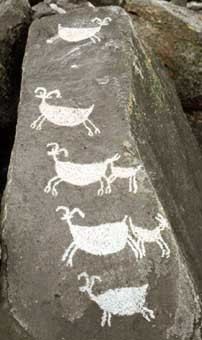NRHP Reference # 99001178 Area 147.5 km² | Designated NHLD July 8, 2001 Added to NRHP 8 October 1999 | |
 | ||
Nearest city China Lake, Kern County, California | ||
Coso Rock Art District, containing the Big and Little Petroglyph Canyons, is a rock art site containing over 100,000 Paleo-Indian and/or Native American Petroglyphs. The Coso Range is between the Sierra Nevada and the Argus Range. Indian Wells Valley lies to the south of this location. This north-south trending range of about 400 square miles (1,000 km2) consists of rhyolitic domes and outcrops of volcanic rock. Also known as Little Petroglyph Canyon and Sand Tanks, Renegade Canyon is but one of several major canyons in the Coso Range, each hosting thousands of petroglyphs (other locations include Haiwee Springs, Dead End Canyon, and Sheep Canyon). The majority of the Coso Range images fall into one of six categories: bighorn sheep, entopic images, anthropomorphic or human-like figures (including animal-human figures known as pattern-bodied anthopomorphs), other animals, weapons & tools, and “medicine bag” images. Fortunately for the petroglyphs, most of the Coso Range is on the Naval Air Weapons Station China Lake, where visitation is restricted, vandalism is low, and preservation is most likely. China Lake is located near the towns of China Lake and Ridgecrest, California. There are several other distinct canyons in the Coso Rock Art District besides the Big and Little Petroglyph Canyons. The most popular subjects are bighorn sheep, deer, and antelope. Big and Little Petroglyph Canyons were declared a National Historic Landmark in 1964. In 2001, they were incorporated into a larger National Historic Landmark District, called Coso Rock Art District.
A November 2007 Los Angeles Times' Travel feature article includes it within a top 15 list of California places to visit. The area was also mentioned in Groupon's "10 Most Unique Autumn Festivals in the Country" as a part of the Ridgecrest Petroglyph Festival.
Prehistory detail
According to that article: "No one knows for sure who decorated Little Petroglyph Canyon with images out of a dreamscape, some thought to be more than 10,000 years old. Or why the basalt walls of a narrow wash in the bone-dry Coso Mountains at the northern edge of the Mojave Desert became a magic canvas for flocks of bighorn sheep, hunters with bows and arrows poised and more. But the area is probably the richest Amerindian Petroglyph / rock-art site in the Western hemisphere. To see the canyon, one must contact either the Navy Base, or join a scheduled tour offered by Maturango Museum in Ridgecrest, California or attend a Rock Art 101 program. A 40-mile drive on paved road except for the last 6 miles to access the trailhead, followed by a hike and a scramble along the canyon. Visits are scheduled only in the spring and fall."
There is considerable archaeological evidence substantiating trade between the Coso People, possibly of the Northern Utoaztecan affiliation Paiute tribe, and other Indigenous peoples of the Americas and Native American tribes. For example, distant trade with the Chumash People is confirmed by archaeological recovery from coastal California sites in San Luis Obispo County and in prehistoric sites on the Channel Islands.
